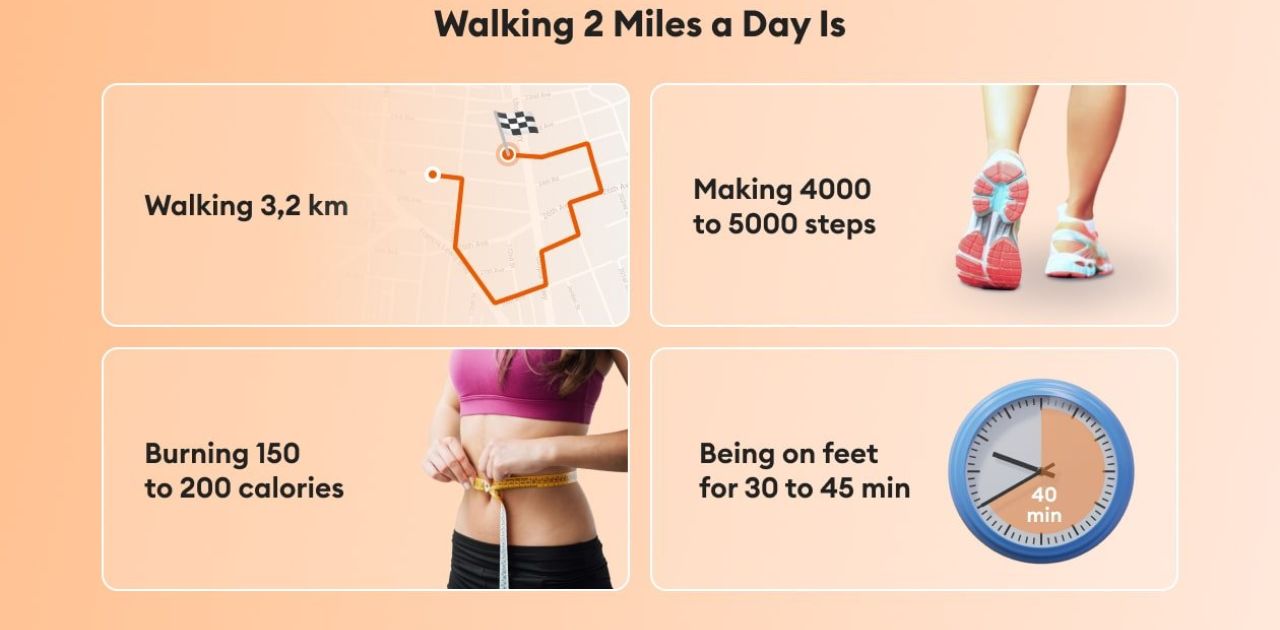Walking is one of the simplest and most effective forms of exercise, offering numerous health benefits. Whether you’re aiming to boost your fitness, manage your weight, or just enjoy some fresh air, setting a goal to walk a certain distance each day is a great way to stay motivated.
One common question people have is: how long does it take to walk 2 miles? The answer can vary depending on factors such as your walking speed, the terrain, and your overall fitness level. In this article, we will delve into the typical time it takes to walk 2 miles and share tips to help you improve your walking routine and stay active.
How Long Does It Take to Walk 2 Miles?
Walking 2 miles is a common goal for many people who are looking to stay fit and healthy. The time it takes to walk this distance can vary widely depending on several factors, including walking speed, fitness level, age, and terrain.
Average Walking Speeds
On average, it takes about 30 to 45 minutes to walk 2 miles at a moderate pace. This equates to a walking speed of approximately 3 to 4 miles per hour (mph). However, individual walking speeds can vary. For example, a brisk pace of 4 mph might allow someone to complete the distance in 30 minutes, while a more leisurely pace of 3 mph could take closer to 40 minutes.
Factors Affecting Walking Time
- Fitness Level: Individuals who are more physically fit may walk faster and with less effort than those who are not as conditioned.
- Age: Age can impact walking speed. Younger individuals tend to walk faster than older adults.
- Terrain: Walking on flat, even surfaces typically takes less time than walking on hilly or uneven terrain.
- Health Conditions: Chronic health conditions, such as arthritis or respiratory issues, can affect walking speed and endurance.
- Purpose of Walk: The time taken can also depend on whether the walk is for exercise, leisure, or a specific task, like commuting.
How Far is 2 Miles?
Understanding the distance of 2 miles in various contexts can help frame your walking goals and expectations.
Conversion to Other Units
- Kilometers: 2 miles is equivalent to approximately 3.21 kilometers.
- Steps: The number of steps required to cover 2 miles depends on stride length. On average, it takes about 4,000 to 5,000 steps to walk 2 miles. This varies based on individual stride length, which can be influenced by height and walking speed.
Average Time to Walk 2 Miles for Women by Age
The time it takes for women to walk 2 miles can differ significantly based on age and fitness levels. Here’s a general breakdown:
| Age Group | Speed (mph) | Time (mins) |
| 20-29 | 4.2 | 28.57 |
| 30-39 | 4.0 | 30.00 |
| 40-49 | 3.8 | 31.58 |
| 50-59 | 3.5 | 34.29 |
| 60+ | 3.3 | 36.36 |
Younger women tend to have a faster walking pace compared to older women. As age increases, the average walking speed may decrease, resulting in longer times to complete the 2-mile distance.
Average Time to Walk 2 Miles for Men by Age
Similarly, the walking times for men also vary by age and physical condition:
| Age Group | Speed (mph) | Time (mins) |
| 20-29 | 4.2 | 28.57 |
| 30-39 | 4.0 | 30.00 |
| 40-49 | 3.8 | 31.58 |
| 50-59 | 3.5 | 34.29 |
| 60+ | 3.3 | 36.36 |
Generally, men walk slightly faster than women, resulting in shorter times to cover the same distance.
What are the Health Benefits of Walking?
Walking is more than just a simple form of exercise. It offers a plethora of health benefits that can improve both physical and mental well-being.
1. Improves Heart Health
Walking regularly can significantly improve cardiovascular health. Engaging in daily walks helps to lower blood pressure, improve cholesterol levels, and reduce the risk of heart disease. A 30-minute daily walk can reduce the risk of heart-related conditions by up to 30%.
2. Helps in Losing Weight
Walking is an effective way to burn calories and lose weight. Depending on your weight and walking speed, walking 2 miles can burn between 100 to 200 calories. Coupled with a healthy diet, regular walking can help manage weight effectively.
3. Reduces the Risk of Dangerous Diseases
Regular walking can lower the risk of developing several chronic diseases, such as type 2 diabetes, certain cancers, and stroke. Research shows that walking 2 to 3 miles a day can reduce the risk of these diseases by up to 40%.
4. Boosts Immunity
Daily walking can strengthen your immune system, making it easier for your body to fight off illnesses and infections. Moderate exercise like walking enhances the circulation of immune cells in the body, which helps in detecting and combating pathogens more effectively.
5. Improves Brain Health
Walking increases blood flow to the brain, which can enhance cognitive function and memory. It also stimulates the release of brain-derived neurotrophic factor (BDNF), a protein that supports brain health and function.
6. Encourages Creative Thinking
Walking has been linked to improved creative thinking. It helps in freeing the mind from distractions, enabling you to think more clearly and come up with innovative ideas. Studies show that walking can boost creativity by up to 60%.
7. Increases Energy
Walking increases oxygen flow throughout the body, which can help you feel more energized and less fatigued. This boost in energy can improve overall productivity and mood.
8. Strengthens Bones and Muscles
Regular walking helps strengthen bones and muscles, reducing the risk of osteoporosis and muscle loss. It also improves balance and coordination, which can help prevent falls in older adults.
9. Improves Mood and Mental Health
Walking is an excellent way to relieve stress and anxiety. It stimulates the release of endorphins, which are natural mood lifters. Regular walking can reduce symptoms of depression and anxiety by up to 30%.
How Do You Make a 2-Mile Walk Interesting?

While walking is beneficial, it can sometimes become monotonous. Here are some tips to make your 2-mile walks more interesting:
Change Your Walking Route
Exploring new routes can keep your walks exciting. Discovering new scenery and paths can make the experience more enjoyable and less routine.
Listen to Your Favorite Music
Listening to music or a podcast can make the time fly by and add an enjoyable element to your walks. Choose upbeat music to keep your pace lively or calming tunes for a more relaxed walk.
Walk with a Friend
Walking with a friend or family member can make the activity more enjoyable. It provides an opportunity for social interaction and mutual motivation.
Set Goals
Setting goals can add a sense of achievement to your walks. Challenge yourself to walk a certain distance, improve your pace, or increase the duration gradually.
Add Strength Exercises
Incorporate strength exercises such as squats, lunges, or push-ups during your walk. This can help improve your overall fitness and make your walk more dynamic.
How Many Steps Are in 2 Miles?
The number of steps required to walk 2 miles depends on your stride length. On average:
- Men: Approximately 2.5 feet per stride
- Women: Approximately 2.2 feet per stride
Example Calculation
For men:
- 5,280 feet per mile / 2.5 feet per stride = 2,112 steps per mile
- 2,112 steps per mile x 2 miles = 4,224 steps
For women:
- 5,280 feet per mile / 2.2 feet per stride = 2,400 steps per mile
- 2,400 steps per mile x 2 miles = 4,800 steps
These are approximate values as individual stride length can vary.
How Many Calories Do You Burn Walking 2 Miles?
The number of calories burned walking 2 miles depends on factors such as weight, walking speed, and terrain. On average, walking 2 miles at a moderate pace can burn approximately 100 to 150 calories.
Calorie Burn Estimates
| Weight (lbs) | Calories Burned (approx.) |
| 120 | 360-450 |
| 150 | 450-560 |
| 180 | 540-680 |
| 200 | 600-750 |
| 250 | 750-940 |
These values can vary based on individual metabolism and walking conditions.
Is Walking 2 Miles Daily Enough?
Walking 2 miles daily is a great start to becoming more physically active. It offers numerous health benefits, but whether it’s “enough” depends on your fitness goals, age, and current fitness level.
General Health
For general health, adults should aim for at least 150 minutes of moderate-intensity exercise per week. Walking 2 miles a day at a moderate pace, which takes about 30 to 40 minutes, contributes significantly to this goal.
Weight Loss and Fitness Goals
If you’re looking to lose weight or improve specific fitness levels, you might need to increase the distance, pace, or incorporate other types of exercises into your routine. Combining walking with strength training and a healthy diet can enhance overall results.
Can 2 Miles Daily Walk Help to Lose Weight?
Walking 2 miles a day can contribute to weight loss as part of an overall healthy lifestyle. While you can’t target fat loss in specific areas of the body through exercise alone, walking helps burn calories, which in turn can reduce overall body weight.
Creating a Calorie Deficit
The key to weight loss is creating a calorie deficit, where you burn more calories than you consume. Regular walking, especially at a moderate or brisk pace, can effectively burn calories and, when combined with a balanced diet, can help you reduce body weight over time.
How to Track My Walk Time?
Tracking your walking time can be both motivating and informative. Here are some methods to track your walking time accurately:
Smartphone Applications
There are many tracking applications available that can track your walking distance and time. These apps use your GPS data to provide accurate measurements. Some popular tracking applications include Strava, MapMyWalk, and Runkeeper.
Wearable Devices
Wearable devices such as smartwatches and fitness trackers can track your walking distance, speed, time, and calories burned. Devices like Fitbit, Apple Watch, and Garmin are popular choices.
Stopwatch
If you prefer a simpler method, you can use a stopwatch to estimate your walking time. Start the time when you begin your walk and stop when you have completed it.
Treadmill
If you are walking on a treadmill, it’s easy to track your walking time as most treadmills provide detailed information about your workout, including time, distance, and speed.
Mapping Tools
Online mapping tools like Google Maps can help you measure the distance of your walking route before and after your walk. Note the distance covered and determine your walking time by combining the start and end times.
Walking Tips for Beginners
For those new to walking as a form of exercise, here are some tips to get started:
Wear Proper Walking Gear
It’s essential to have suitable shoes for your walking plan. Running shoes can also be used, but open shoes or sandals should be avoided. Comfortable and breathable clothes are also recommended.
Hydrate Yourself
Ensure you drink adequate water before, during, and after your walk. If you sweat profusely, you may want to use electrolyte replacement drinks.
Maintain Energy Levels
Walking for one or two hours a day requires energy. Consume a balanced diet to maintain your body’s energy levels.
Stretch Your Muscles
After walking, perform proper exercises to stretch your hamstrings, quads, glutes, and any tight or sore muscles.
Make Your Walk Enjoyable
Try to make your walk more enjoyable by taking friends or family with you, listening to music, or finding other ways to enhance the experience.
Conclusion
Walking is more than just a way to get from point A to point B; it’s a gateway to improved health, a happier mind, and a longer life. By incorporating a 2-mile walk into your daily routine, you’re taking a significant step towards better cardiovascular health, stronger muscles and bones, weight management, and a reduced risk of chronic diseases. Walking also offers mental health benefits, such as reduced stress and anxiety, and fosters creativity and clearer thinking.
To embark on this journey, start by setting clear goals, choosing a safe and enjoyable route, and gradually building up your pace and distance. Remember the importance of warming up, cooling down, and listening to your body to avoid injury and ensure your walking routine is sustainable and enjoyable.
Safety Tips
When walking outdoors, especially if you prefer early mornings or evenings, prioritize your safety with these tips:
- Make sure you’re visible to drivers, cyclists, and other pedestrians.
- Stick to paths that are well-lit and avoid secluded areas.
- Use only one earbud if you enjoy walking with music, so you can stay alert to your surroundings.
- Cross at designated crossings, follow traffic signals, and always walk on the sidewalk when available.
By following these guidelines and staying committed to your walking routine, you can enjoy the multitude of benefits that walking has to offer. Whether you’re walking for health, fitness, or pleasure, remember that every step counts towards a healthier and happier you.
Read Also: How do I cancel my Orangetheory membership? (5 steps detailed Guide)

Passionate sportsman and writer, delivering insightful analysis and updates on the latest in sports. Always on the pulse of action.



